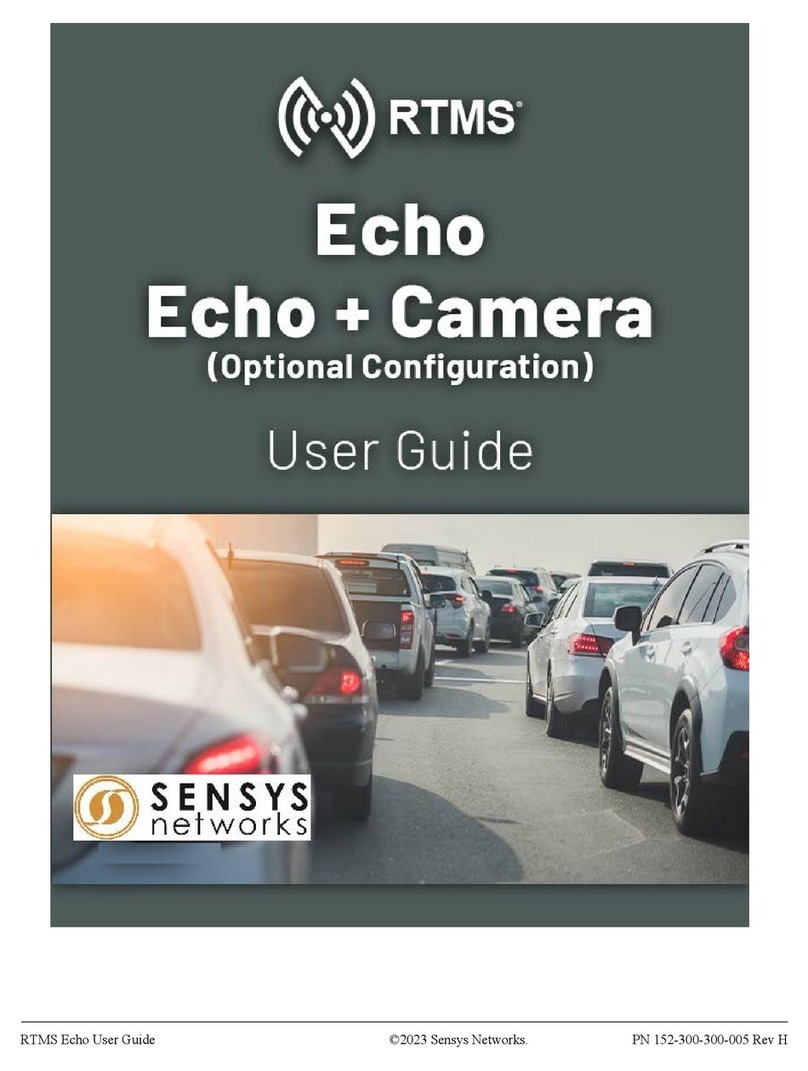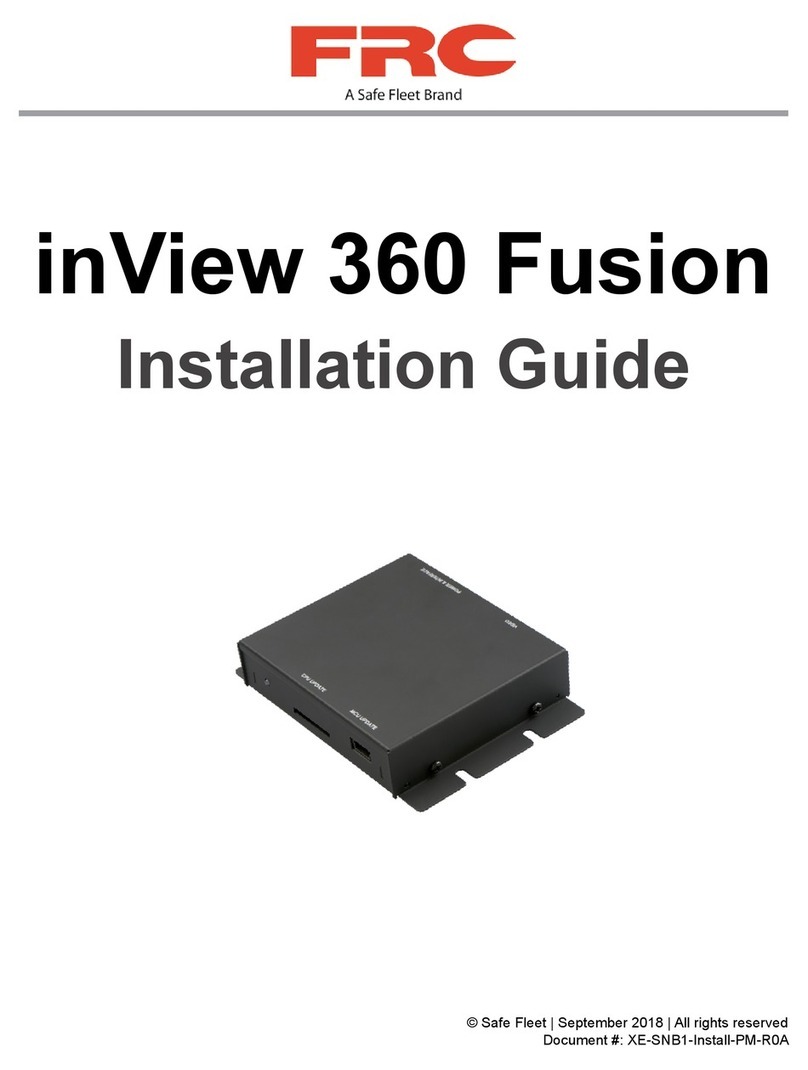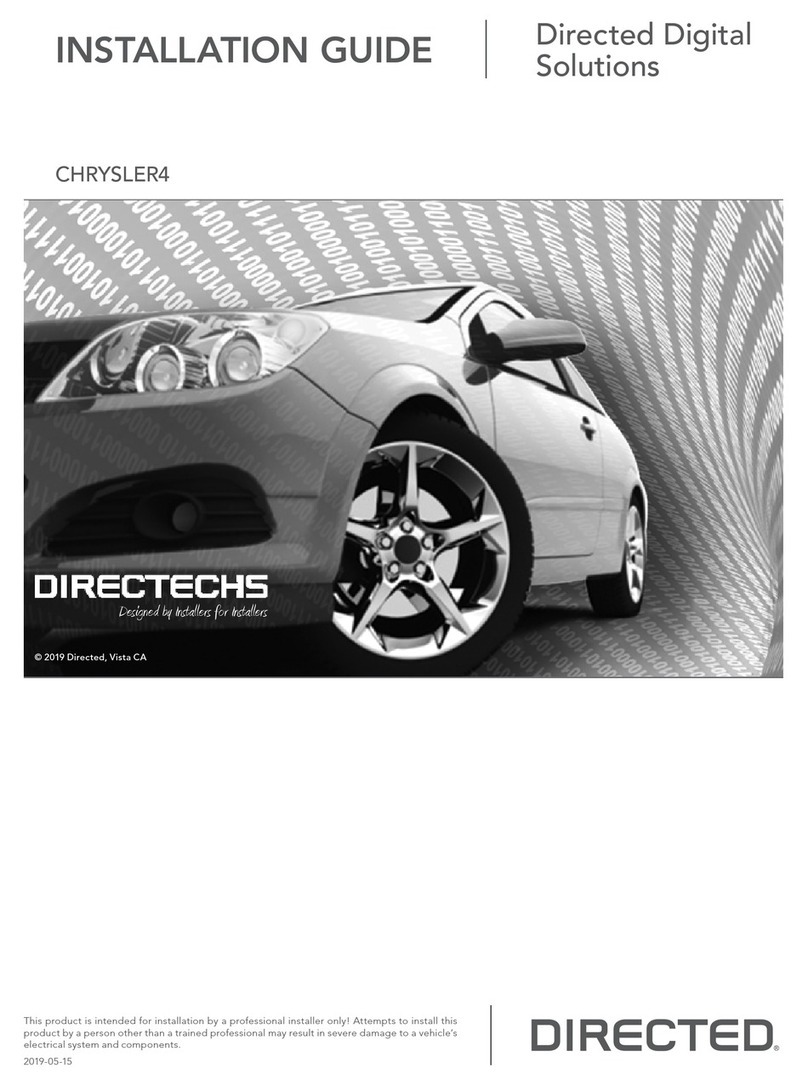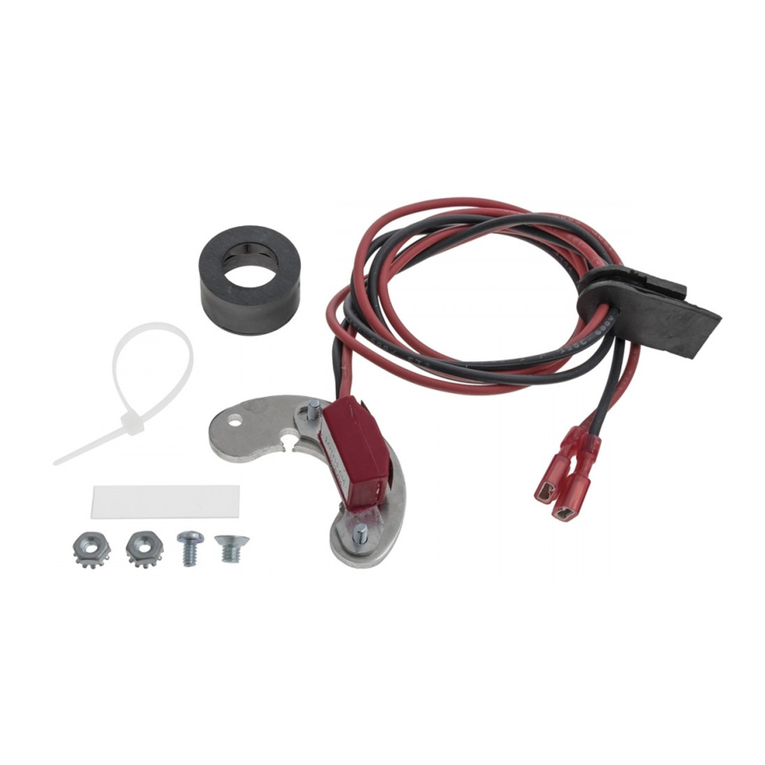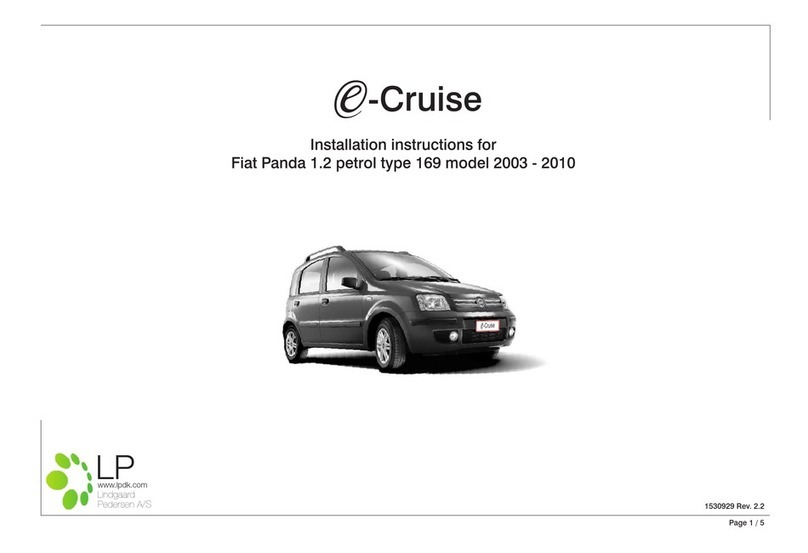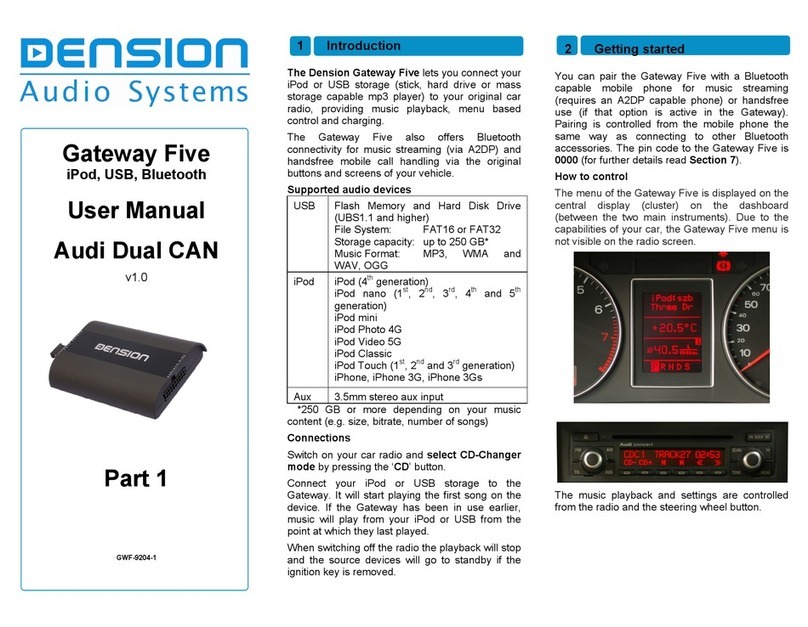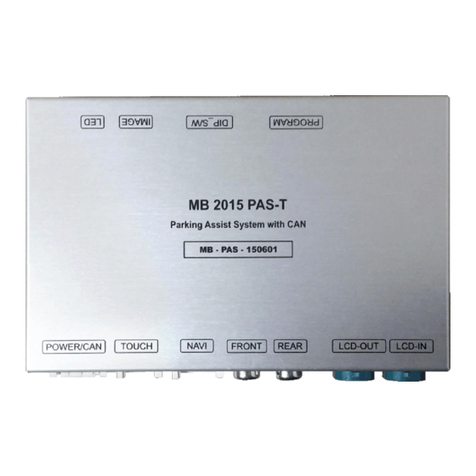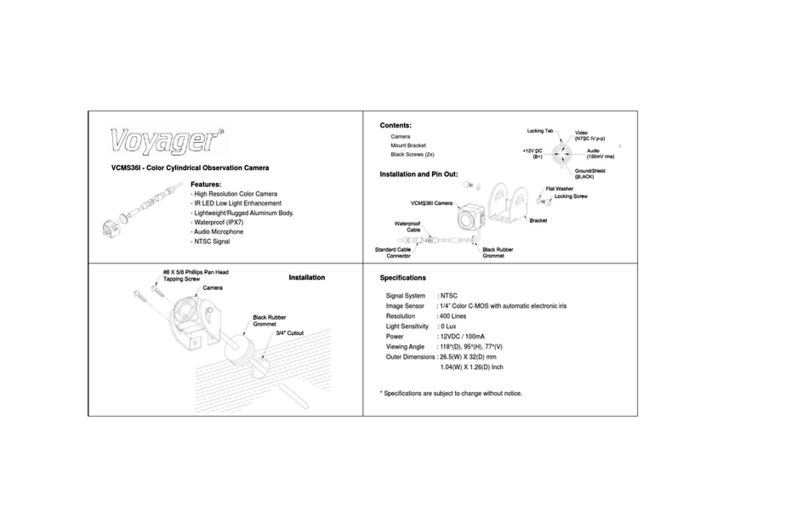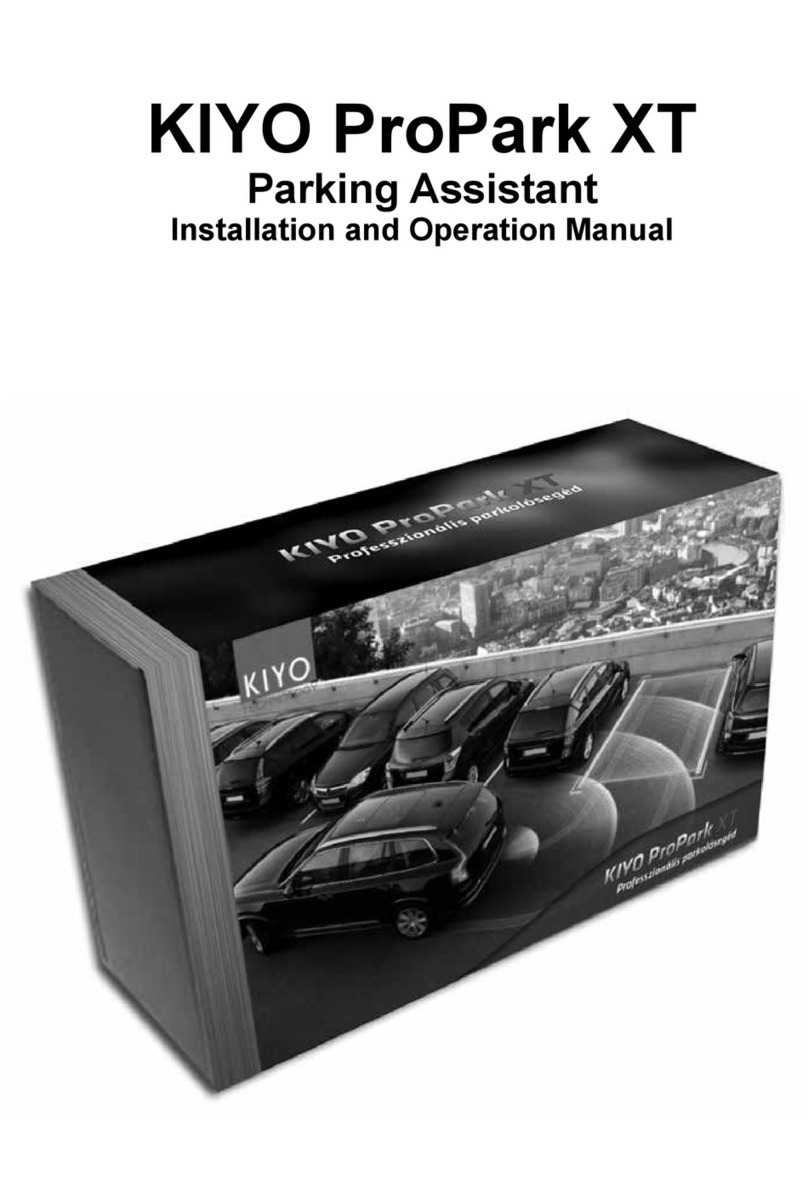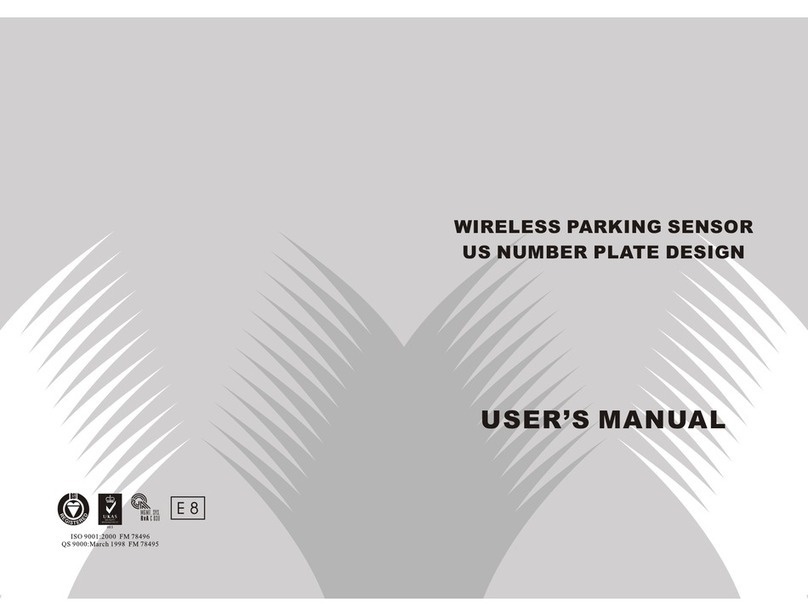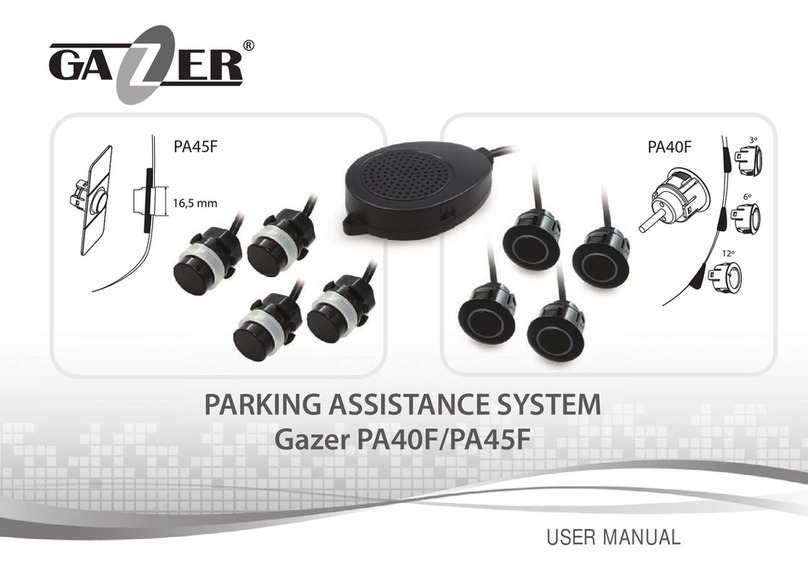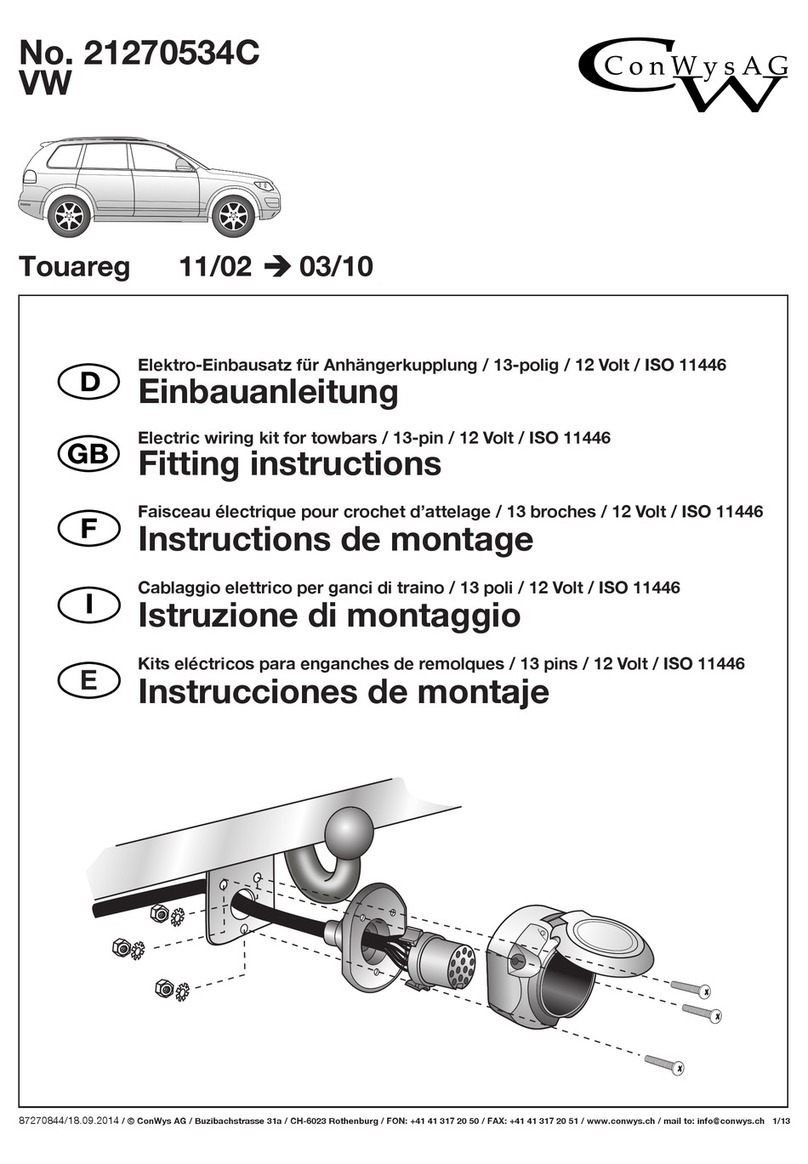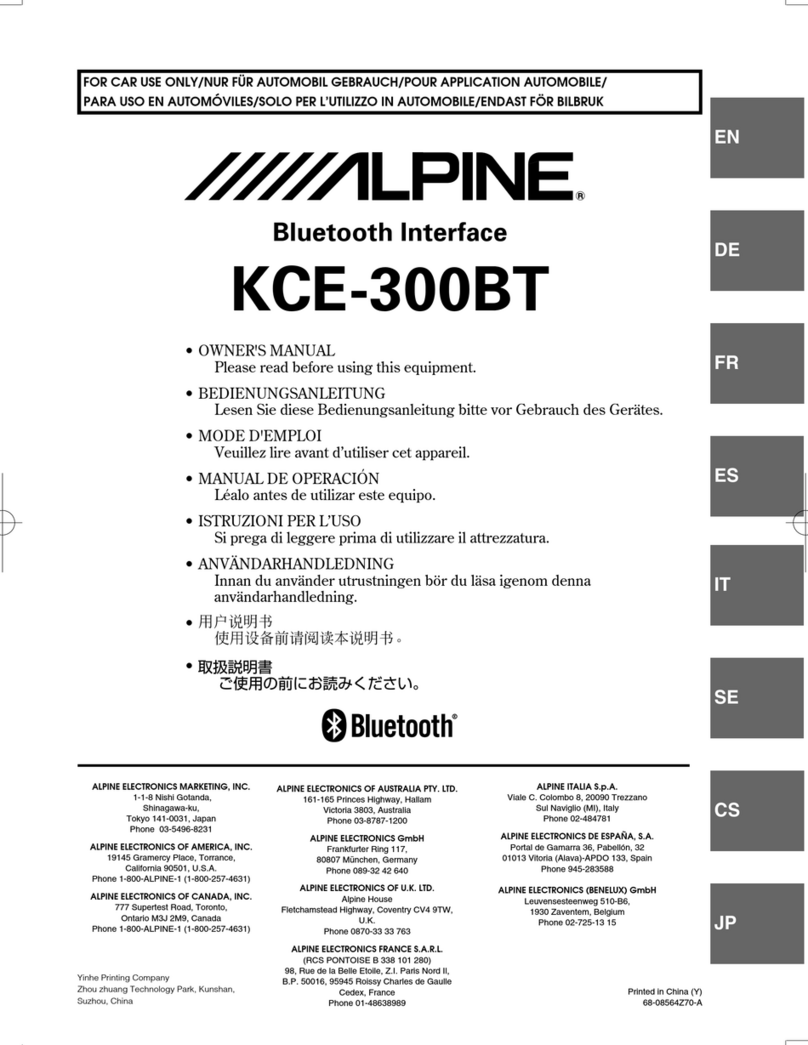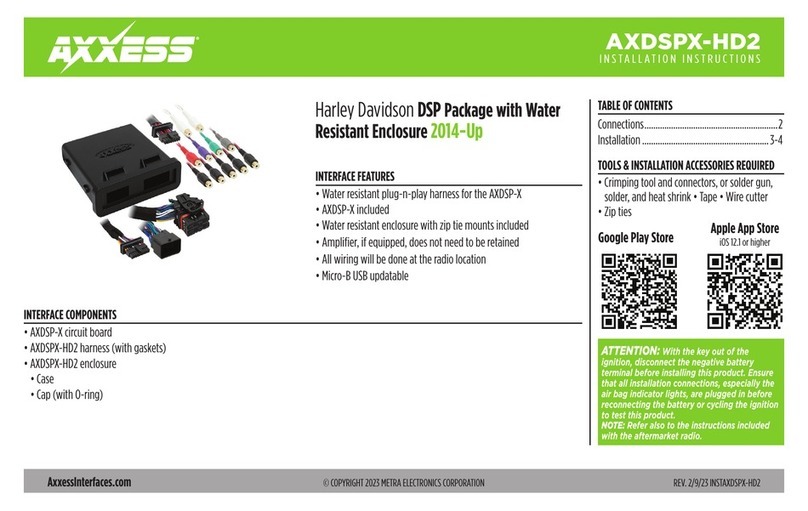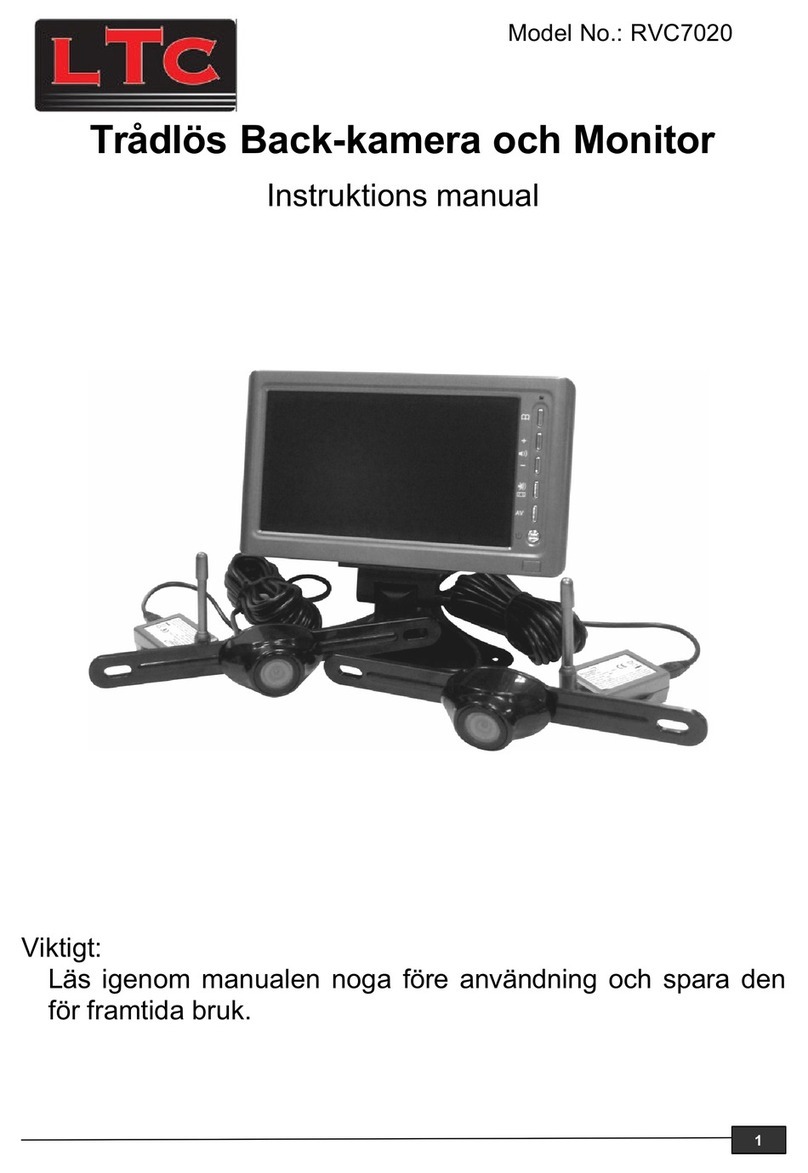Sensys Networks VDS240 User manual

Radio (SPP) / FlexRadio Cabinet
Sensys Networks VDS240 Wireless Vehicle
Detection System
Radio (SPP) and FlexRadio Cabinet Installation Guide
P/N 152-240-030-006, Rev A
August 2019

Document Properties
This document is reference material for the Sensys Networks VDS240 wireless vehicle
detection system from Sensys Networks, Inc.
P/N 152-240-030-006, Rev A
Sensys Networks, Inc. makes no representation or warranties with respect to the
contents hereof and specifically disclaims any implied warranties of merchantability or
fitness for any particular purpose. Furthermore, Sensys Networks reserves the right to
revise this publication and to make changes from time to time in the content hereof
without obligation of Sensys Networks to notify any person or organization of such
revisions or changes.
© 2007 - 2019 – All rights reserved.
Sensys Networks and the Sensys Networks logo are trademarks of Sensys Networks,
Inc. All other products, names and services are trademarks or registered trademarks of
their respective owners.
Regulatory Statements
FCC Compliance Statement
This device complies with part 15 of the FCC rules. Operation is subject to the following
two conditions:
(1) This device may not cause harmful interference.
(2) This device must accept any interference received, including interference that
may cause undesired operation.
Any changes or modifications to this product not authorized by Sensys Networks could
void the EMC compliance and negate the authority to operate the product.
RF Exposure Statement
This device has been tested and meets the FCC RF exposure guidelines. It should be
installed and operated with a minimum distance of 20 cm between the radiator of RF
energy and the body of users, operators, or others.
Improper use or tampering with the device is prohibited and may not ensure
compliance with FCC exposure guidelines.
Warnings
No Safety Switching
Sensys Networks does not allow its equipment to be used for safety applications such
as controlling a mechanical gate or switching a train to avoid a collision.

Lithium Thionyl Chloride Batteries
Sensys Networks uses Lithium Thionyl Chloride batteries in the following products:
Sensors (VSN240-F, VSN240-T, VSN240-S, VSN240-M, VSN240-M-2,
VSN240-F-2, VSN240-T-2)
Repeaters (RP240-BH-2, RP240-BH-LL-2, FLEX-RP-B-2, FLEX-RP-B-LL-2,
FLEX-RPT3-SLR)
Lithium batteries are widely used in electronic products because they contain more
energy per unit -weight than conventional batteries. However, the same properties that
deliver high energy density also contribute to potential hazards if the batteries are
damaged. Improper use or handling of the batteries may result in leakage or release of
battery contents, explosion, or fire.
Following are the recommendations of the battery manufacturer for proper use and
handling of batteries in the Sensys Networks devices mentioned above:
DO NOT charge or attempt to recharge the batteries (they are NOT
rechargeable)
DO NOT crush or puncture batteries
DO NOT short-circuit the batteries
DO NOT force over-discharge of the batteries
DO NOT incinerate or expose batteries to excessive heating
DO NOT expose battery contents to water
DO dispose of batteries and devices containing batteries in accordance with
local regulations
N
OTE
:
Sensys Networks wireless sensors contain no serviceable parts and should never be
disassembled. Installation and removal of sensors from pavement should only be done by
trained personnel and care should be taken to insure that the sensor casing is not punctured
or crushed.
Additional safety information is available from the battery's manufacturer:
Sensor battery cell: http://sensysnetworks.com/sensorbattery
Repeater battery cell: http://sensysnetworks.com/repeaterbattery
Document Control
Sensys Networks continually reviews and revises its technical publications Please

Sensys Networks Technical Publications
For additional information regarding Sensys Networks products and applications,
design guides, configuration guides, and best practices, refer to the Sensys Networks
technical documents library available at http://sensysnetworks.com/
resources?tech_docs.
Contact Information
Sensys Networks, Inc.
1608 Fourth Street, Suite 200
Berkeley, CA 94710 USA
+1 (510) 548-4620
www.sensysnetworks.com

Sensys Networks, Inc. Radio (SPP) / FlexRadio Cabinet vii
Installation Guide
Contents
Chapter 1: Introduction ............................................................................................... 1
What's Inside ..................................................................................................................................1
Chapter 2: Overview ................................................................................................... 2
FlexControl .....................................................................................................................................2
Contact Closure Expansion Card .........................................................................................2
Types of FlexControl Configurations ...........................................................................................3
FlexControl System .................................................................................................................3
Radio (SPP) ........................................................................................................................4
Isolator and FlexIsolator ...................................................................................................4
FlexRadio Cabinet ...........................................................................................................4
Radio (SPP) Package Contents ...................................................................................................6
Universal Mounting Kit Contents ...........................................................................................7
Additional Parts and Equipment Required ................................................................................7
Chapter 3: Radio (SPP) Installation Considerations .................................................. 9
Powering the Radio (SPP) ............................................................................................................9
Acquiring Power From a Traffic Controller ...........................................................................9
Acquiring Power From Traffic Controller Using an Isolator ...............................................10
Voltages .................................................................................................................................11
Cabling ..................................................................................................................................11
Determining the Location of the Radio (SPP) ..........................................................................11
Optimal Location Criteria ....................................................................................................11
Chapter 4: Radio (SPP) Installation Procedures ...................................................... 12
Tools Required for Radio (SPP) Installation ...............................................................................12
Step-by-Step Procedures ...........................................................................................................13
Installing the Mounting Plate on Poles ...............................................................................13
Installing the Mounting Plate on Walls ...............................................................................14
Installing the Mounting Plate on Beams .............................................................................14
Determining the Type of Radio (SPP) Radio Bulkhead Connector .................................14
Radio (SPP) Radio Bulkhead Connector .....................................................................15
Connecting the Cable to a Radio (SPP) Radio with the Hex-head Connector ...........15
Components ...................................................................................................................15
Step-by-Step Procedures .....................................................................................................16
Proper Fit (little to no gap between edges of cut) ....................................................19
Improper Fit (gap between edges of cut) ..................................................................19
Proper Fit (bushing fully seated into guides) ...............................................................20
Improper Fit (bushing poorly seated into guides) ......................................................21
Proper Fit (recessed bushing, smooth face) ...............................................................22

Sensys Networks, Inc. Radio (SPP) / FlexRadio Cabinet viii
Installation Guide
Improper Fit (bushing not recessed, pinched edge, mushroomed face) ..............22
Removing the Cable Connection ......................................................................................22
Chapter 5: FlexRadio Cabinet Installation Procedures .......................................... 24
Tools Required for FlexRadio Cabinet Installation ...................................................................24
Installation of FlexRadio Cabinet ..............................................................................................25
Assembly of DIN Mount/Bracket Mount for FlexRadio Cabinet ......................................25
Installing Omni Directional Antenna ..................................................................................25
Prep Surface ...................................................................................................................25
Drill a Hole in Traffic Cabinet ........................................................................................26
Thread Connectors into Cabinet .................................................................................27
Connect Cables to the FlexRadio Cabinet .......................................................................28
Appendix A: Clamp Band Tool Guide ..................................................................... 30
Appendix B: Perforated Clamp Band User Guide .................................................. 31
Installing the Mounting Plate Using Perforated Steel Banding ........................................31

Sensys Networks, Inc. Radio (SPP) / FlexRadio Cabinet ix
Installation Guide

Introduction
Radio (SPP) / FlexRadio Cabinet 1
Sensys Networks, Inc. Installation Guide
Chapter 1
Introduction
This guide provides information and procedures for installing Sensys Networks
Radio (SPP) and FlexRadio Cabinet in conjunction with the Sensys Networks
VDS240 wireless vehicle detection system. This document is intended to be used
by Sensys Networks customers, consultants, partners, dealers, and those who are
interested in the application of wireless communication technology to the
challenges of traffic detection, management, and control.
What's Inside
This guide includes the following information:
Chapter 1: Introduction, defines the purpose and scope of the guide.
Chapter 2: Overview, provides an overview of the FlexControl and its additional
components. It also describes the contents of a product shipment.
Chapter 3: Radio (SPP) Installation Considerations, provides the installation
considerations for the Radio (SPP).
Chapter 4: Radio (SPP) Installation Procedures, provides instructions for installing
and mounting the Radio (SPP).
Chapter 5: FlexRadio Cabinet Installation Procedures, provides instructions for
installing a FlexRadio Cabinet.
Appendix A: Clamp Band Tool Guide, provides clamp band usage and specifications
Appendix B: Perforated Clamp Band User Guide, provides perforated clamp band
usage and specifications.

Overview
Radio (SPP) / FlexRadio Cabinet 2
Sensys Networks, Inc. Installation Guide
Chapter 2
Overview
This chapter provides an overview of the Radio (SPP) and the FlexRadio Cabinet
and its adjacent components. The chapter also describes the contents of a product
shipment. Unless otherwise noted, the document uses the term FlexControl to
apply equally to the following:
FlexControl Card (APCC)
FlexControl Module
FlexControl
The Sensys Networks VDS240 Wireless Vehicle Detection System detects the
presence and movement of vehicles with magneto-resistive sensors mounted in
the pavement. Wireless sensors continuously transmit detection data to the
FlexControl that collects and forwards data to remote traffic management systems
or local traffic signal controllers such as the CalTrans Type 170, Type 2070 ATC
and NEMA TS-1, and TS-2 controllers.
The Sensys Networks FlexControl, is a second generation controller card that
maintains low power consumption, supports multiple radios, and allows for
additional communication and processing power. The FlexControl, which is
compatible with all of Sensys Networks VDS240 Wireless Vehicle Detection
System products, receives and processes data from the sensors. The FlexControl
then relays the sensor detection data to a roadside traffic controller or remote
server traffic management system.
Contact Closure Expansion Card
Additional capacity (to handle more sensors or controller channels) is provided by
a contact closure expansion card (EX card). EX cards use the same form factor as
FlexControl Card (APCC) and are daisy-chained to an EE interface on the

Overview
Radio (SPP) / FlexRadio Cabinet 3
Sensys Networks, Inc. Installation Guide
FlexControl on the front-panel RJ45 jacks. Up to 63 EX cards can be used per
FlexControl.
Types of FlexControl Configurations
The FlexControl consists of dual radio ports, Sensys Networks Expansion (EX)
port, and dual USB 2.0 full speed host ports and 10/100Base-T network access.
The FlexControl also contains contact closure interface via backplane to a traffic
controller.
Figure 2.1. APCC configuration (left) and FlexControl configuration (right)
FlexControl System
The minimum FlexControl system consists of a FlexControl and one Radio (SPP)
radio. The system can also consist of multiple Radios (SPP) and an isolator that
offers electrical isolation up to 1500V, surge protection up to 1500V, and AC power
cross protection.
Figure 2.2. FlexControl system configuration

Overview
Radio (SPP) / FlexRadio Cabinet 4
Sensys Networks, Inc. Installation Guide
Radio (SPP)
The Radio (SPP) maintains two-way wireless links to an installation’s sensors and
repeaters, establishes overall time synchronization, and transmits configuration
commands and message acknowledgments.
Figure 2.3. Radio (SPP)
Isolator and FlexIsolator
The isolator and FlexIsolator are optional components that provides the following
services:
connects a Radio (SPP) to the FlexControl, FlexIsolator connects two Radios
(SPP) to the FlexControl
isolates and routes power from the controller backplane to the Radio (SPP)
extends the communication for the FlexControl to and from the Radio (SPP) at
RS422 distance.
Figure 2.4. Isolator (left) and FlexIsolator (right)
FlexRadio Cabinet
The FlexRadio Cabinet is a module mounted inside the traffic cabinet with an
external omni directional antenna mounted on top of the cabinet. This method of
installation allows the FlexRadio Cabinet to communicate with repeaters without
the need for running cables through external conduits.
Figure 2.5. FlexRadio Cabinet

Overview
Radio (SPP) / FlexRadio Cabinet 5
Sensys Networks, Inc. Installation Guide
The FlexRadio Cabinet is a low powered radio that maintains two-way wireless
links to an installation’s repeaters. The FlexRadio Cabinet establishes overall time
synchronization, transmits configuration commands and message
acknowledgments, and receives data from the sensors and repeaters. The
FlexRadio Cabinet then relays the data to the FlexControl Module over a CAT5
cable.
Figure 2.6. FlexRadio Cabinet connection diagram
A typical configuration consists of one FlexControl Module, one FlexRadio
Cabinet, and an omni directional antenna. The FlexRadio Cabinet can be mounted
in the cabinet by a DIN or bracket mount that is provided by Sensys Networks. The
external omni directional antenna connects to the FlexRadio Cabinet via a coaxial
cable. The external antenna must have gain less than +6 dBi to meet regulatory
requirements.

Overview
Radio (SPP) / FlexRadio Cabinet 6
Sensys Networks, Inc. Installation Guide
Radio (SPP) Package Contents
Each Radio (SPP) is shipped with the items listed below. Verify that you have
received all of them. In the event that some items are missing, contact Sensys
Networks or the party that supplied the equipment to you.
The items in an Radio (SPP) shipment include:
A Radio (SPP)
“Tool less” push/pull Ethernet bulkhead connector
Item that is shipped separately:
Universal mounting kit (mounting kit can be purchased from Sensys
Networks)
Radios (SPP) are shipped with a factory default configuration suitable for bench-
testing the device and applicable to many field environments. The information
sheet details the physical attributes of the Radio (SPP) as well as key configuration
elements.
Radio (SPP) information sheets contain the following elements:
Serial number – a globally unique identifier for the Radio (SPP)
Firmware release version

Overview
Radio (SPP) / FlexRadio Cabinet 7
Sensys Networks, Inc. Installation Guide
Universal Mounting Kit Contents
The following parts are included in the Radio (SPP) mounting kit:
Surface mounting ball plate (refer to Figure 2.6)
Figure 2.7. Surface (wall/beam/pole) mounting ball plate (square)
Double socket arm (refer to Figure 2.7)
Figure 2.8. Double socket arm
5-foot clamp band
Clamp band tool
Additional Parts and Equipment Required
Additional parts and equipment required for installation and configuration of a
Radio (SPP) include the following:
Standard Ethernet compatible, outdoor rated, 4-pair CAT5 (or better) cable
(refer to Notes below)
RJ45 jack kit and crimp tool
Cable ties
Banding tool
Hammer

Overview
Radio (SPP) / FlexRadio Cabinet 8
Sensys Networks, Inc. Installation Guide
PC or laptop with Microsoft®Windows®XP Professional or Windows 7
(including 64-bit editions) and TrafficDOT, the system management software
tool from Sensys Networks.
NOTE:
The FlexControl is available with a range of options. Verify that the FlexControl you are
using with the contact closure card(s) is appropriate for that use.
Notes
1. Cabling – a minimum of one straight-through Ethernet cables are
required.
2. Laptop PC and TrafficDOT software – if contact closure cards will be
configured via TrafficDOT's GUI, a suitable host is required.
3. Contact closure card functions can be configured from the switches on the
front panel eliminating the need for a laptop PC and TrafficDOT.

Radio (SPP) Installation Considerations
Radio (SPP) / FlexRadio Cabinet 9
Sensys Networks, Inc. Installation Guide
Chapter 3
Radio (SPP) Installation
Considerations
This chapter provides the installation considerations for the Radio (SPP). Prior to
installing the Radio (SPP), ensure that the following aspects have been considered
in the site design.
Powering the Radio (SPP)
Determining the location of the Radio (SPP)
Each consideration is discussed below. In addition, refer to the Sensys Networks
Wireless Vehicle Detection System Reference Guide, Design Guidelines for
Freeway Applications, and Design Guidelines for Intersection Applications for
more information.
Powering the Radio (SPP)
The overall network design determines how the Radio (SPP) is powered; two
general models are supported:
Acquiring power directly from a traffic controller cabinet
Acquiring power from a traffic controller using optional isolator
Acquiring Power From a Traffic Controller
A Radio (SPP) can be directly interfaced to a traffic signal controller through an
FlexControl. When this is the case, power to the Radio (SPP) is drawn from the
traffic controller as shown in the following figure.

Radio (SPP) Installation Considerations
Radio (SPP) / FlexRadio Cabinet 10
Sensys Networks, Inc. Installation Guide
Figure 3.1. Radio (SPP) radio powered from a traffic controller
Acquiring Power From Traffic Controller Using an Isolator
An optional isolator can be used when acquiring power from the traffic controller
as shown in following figure.
Figure 3.2. Radio (SPP) radio powered from a traffic controller

Radio (SPP) Installation Considerations
Radio (SPP) / FlexRadio Cabinet 11
Sensys Networks, Inc. Installation Guide
Voltages
The FlexControl uses the following voltages drawn from one of the following
sources:
20VDC – 28 VDC (24 VDC nominal) – typically supplied from a nearby traffic
controller cabinet or power pole
10VDC – 16 VDC (12 VDC nominal) – typically supplied from a solar panel
Cabling
Standard Ethernet compatible, outdoor rated, 4-pair CAT5 or better cable is
required. The maximum cable length is 328 feet (100 meters) or 2,000 ft (610
meters) with isolator. The cable should be terminated with RJ45 connectors
according to the TIA/EIA 568-B specification when it is installed.
Determining the Location of the Radio (SPP)
The physical location of the Radio (SPP) is the primary determinant of
communications quality and, as such, the network's overall usefulness and
reliability. Selecting a location involves several factors (including other local RF
transmissions) that may make pre-assigned locations problematic.
Optimal Location Criteria
Optimal locations for Radio (SPP) digital radios meet all of the following criteria:
are high enough to promote high quality RF communications on a sustained
basis
allow a line-of-sight path to wireless sensors and/or repeaters
are within recommended distances for the FlexControl, (optional) isolator,
wireless sensors and/or repeaters
allow the Radio (SPP) to be mounted with its bulkhead connector pointed
toward the ground
are within specified cable length limits
do not submit the Radio (SPP) to avoidable vibration, shaking, or movement
are reasonably accessible to field support personnel

Radio (SPP) Installation Procedures
Radio (SPP) / FlexRadio Cabinet 12
Sensys Networks, Inc. Installation Guide
Chapter 4
Radio (SPP) Installation Procedures
This chapter provides the instructions for installing and mounting an Radio (SPP).
Installing a Radio (SPP) consists of the following:
Attaching the square surface mounting ball plate to an available vertical
surface
Attaching the Radio (SPP) to the surface mounting ball plate via the double
socket arm
Mounting hardware is included in the universal mounting kit provided with each
Radio (SPP).
Tools Required for Radio (SPP) Installation
The following tools are required for installing an Radio (SPP):
RJ45 crimp tool – to terminate the Radio (SPP) cable. (Sensys Networks
recommends the EZ-RJPRO P/N 100044 from Platinum Tools.)
Figure 4.1. EZ-RJPRO
RJ45 connectors – rated Cat5e or better; to terminate the Radio (SPP) cable
Cat5e cable continuity line tester – to validate cable continuity
Outdoor rated Cat5e Ethernet cable – to build the Radio (SPP) cable; length is
determined by the distance between the Radio (SPP) mounting location and
the source of power (typically a controller cabinet, solar panel or other
available source)

Radio (SPP) Installation Procedures
Radio (SPP) / FlexRadio Cabinet 13
Sensys Networks, Inc. Installation Guide
Lift truck – to install the Radio (SPP) 16 – 30 feet above the road surface
Screwdriver – combination flat and Phillips head ends
Universal mounting kit – double-socket arm holds the Radio (SPP). (Kit can
be purchased from Sensys Networks.)
Clamp band kit – for attaching double-socket arm to mounting pole. (Kit
supplied with universal mounting kit)
Band strap tightening tool – for attaching the mounting plate
Pliers – used to work the clamp band
Small hammer – used to secure the clamp band
Wire cutters – used to cut the clamp band
Step-by-Step Procedures
The square surface mounting ball plate can be installed on any available vertical
surface sufficient to support the Radio (SPP) including poles, walls or beams. This
section provides procedures for pole installation; considerations for wall or beam
mounting follow this section.
Installing the Mounting Plate on Poles
When attaching the square surface mounting ball plate to a pole, the clamp band is
used to secure the ball plate to the pole. (If the clamp band in the mounting kit has
perforations, refer to Appendix B for instructions.)
Follow these steps to perform the installation:
1. Feed the clamp band through the square ball plate (Figure 4.2) until the square
ball plate is at the center of the band.
Figure 4.2. Clamp holes (left), Clamp band threading through the surface mounting ball plate
(middle), and the direction the clamp band should wrap (right)
2. Use the cloth to clean the area of the pole that will meet the ball plate. Remove
the double stick tape cover from the back of the plate, wrap the clamp band
around the pole, and follow the instructions for securing the clamp band to the
pole via Appendix A.
3. Attach the double socket arm to the square ball plate.
Other manuals for VDS240
4
Table of contents
Other Sensys Networks Automobile Electronic manuals
